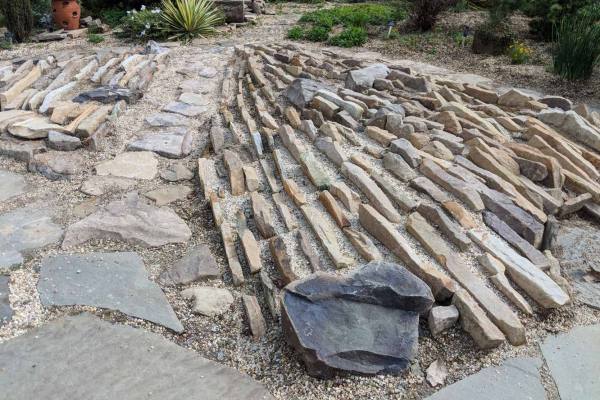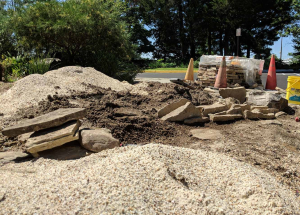THE ROCK GARDEN at Green Spring Gardens in Alexandria, Virginia, was originally designed and created by Don Humphrey, a keen plantsman, skilled propagator, and the first director of the Gardens. An active member in the Potomac Valley Chapter of the North American Rock Garden Society (NARGS), he took advantage of their annual seed exchange to procure future plants for the garden. Don loved propagating rock garden plants from seeds and growing the plants on in his elegant rock garden here at Green Spring.
I never had the pleasure of meeting Don. Former friends and colleagues speak of his incredible plant knowledge and ability to propagate and grow a vast array of plants from all over the country. He is famous for penstemon, eremurus, and other plants we swoon over, and usually kill, here in steamy Zone 7 Virginia. Although his passion for plants was intense and his knowledge impressive, he was extremely personable. At our biannual garden day events, lines of visitors waited patiently for tips and secrets from Don on growing rock garden plants in our area.
As a horticulturist at Green Spring, I am responsible for the rock garden Don established. The bones of Don’s garden are still evident, and some of his original plantings survive today. Don created screes, an alpine lawn, a small meadow, ridges, and an area lined with plastic to hold water for rock garden plants needing boggy conditions. However, one xeric environment Don did not try was a crevice garden. Avid gardeners in the Czech Republic introduced the idea and perfected the building of the crevice garden. Their inspiration is the formations of rocks in the vertical strata found in mountainous regions.
I was first exposed to crevice gardens in the noble state of Colorado, where rock gardening reigns. My heart quickened at the rhythm and texture of upright stones in the Yampa River Valley Garden, the Betty Ford Alpine Garden, and the queen of rock gardens, Denver Botanical Gardens. Acres of rocks grace the state, and these fabulous gardens reflect the state’s dramatic terrain. It was all so wonderful, and, well, seemingly unattainable in northern Virginia.
But when I visited the amazing and delightful urbanite crevice garden at Plant Delights Nursery in Raleigh, North Carolina, during the NARGS 2017 annual meeting, I knew I had to have one. If North Carolina could support a fabulous crevice garden and fill it with cool, rock-loving plants in Zone 7b, I could certainly do it Zone 7a Virginia.
We were awarded two grants to build the crevice garden at Green Springs – one from NARGS to purchase materials and a second from the Pennsylvania Horticulture Society to buy plants.
To research crevice garden construction, I started with an article in Fine Gardening magazine by Joseph Tychonievich. A writer, editor of NARGS Quarterly and author of Rock Gardening: Reimagining a Classic Style, Joseph offers all sorts of tips on creating crevice gardens complete with handy illustrations. Next, I reviewed crevice-garden guru
Kenton Seth’s videos on creating the crevice garden at the JC Raulston Arboretum. Jeremy Schmidt at Plant Delights offered tips in a detailed article on crevice gardening in the Piedmont Chapter’s newsletter. And I went back over the classics, looking for information on rock placement and soils.
Armed with measurements of the space I wanted to renovate, I visited Sisler Stone in Falls Church, Virginia. Based on my vision of the future garden and with advice from staff, I selected one palette of West Virginia fieldstone for my base and purchased small sharp gravel for mulch.
With the help of volunteers, existing plants were cleared from the area, and the surface was smoothed. We then brought in several wheelbarrows of builder’s sand to construct berms into which the stones would be laid. The berms were formed to create a rounded topography with high points roughly in the center. I decided to create a curved path through the space for easier maintenance and to break up the large area we were trying to cover.
Laying the stone was a very organic process, selecting stones for their shape, color, and size. I found it easiest to remove all the stones from the pallet and sort them roughly according to size.
Then the work began. We lined up the rocks on edge and placed them close together end to end. Once I was happy with the arrangement, I dug a narrow trench into the soil to accommodate the stones. Ideally, about 1/3 of the stone remains above the surface. Once the next row is laid, a deep pocket is created where plant roots can grow in between the rocks. The narrow pocket limits the amount of soil around the roots of each plant, promotes good drainage, and forces the roots to grow deeply to find water and protection from the heat of the sun. Digging into the base soil of clay and gravel and packing it tightly around the stones helped to support the heaviest stones.
Since the garden is on a slight slope, I selected particularly large and heavy stones to support the lower slope and hold the soil layer. We also anchored the ends with larger pieces as the area is heavily trafficked.
After the work was completed, I let the garden rest for a few weeks. Crevice garden experts recommend hosing down the garden several times to help the soil flow into spaces and fill pockets created during construction. Because mother nature took care of rain for us this August, I didn’t have to spray it after all. The soil settled in nicely with natural precipitation.
A highly permeable soil mix of two parts sand to one part gravel allows water to drain quickly in our new garden. Water slows as it reaches the base material, which contains clay, sand, and gravel. I am eager to see how plants perform in our soil mix. In some pockets, we played with the soil mix, adding a small amount of compost if the plant specimen required a more nutrient-rich soil. One inch (2.5 cm) of fine sharp-edged gravel mulch helps to keep the crowns of sensitive rock garden plants dry as well as to suppress weeds. I put in Globularia cordifolia, Scutellaria resinosa, Draba cretica, Dianthus microlepis, and Sempervivum. I’m keeping my fingers crossed.
Don Humphrey left a legacy of great horticultural leadership at Green Spring Gardens, and a beautiful rock garden. It has been a pleasure and an honor to work in his shadow. But the garden also evolves: dwarf conifers that have outgrown their spaces have been removed and replaced with smaller specimens, the rock wall was rebuilt, and now a crevice garden graces the space.
I look forward to experimenting with low-growing plants in the new garden and hope to do a bit of zone pushing. Remember, it just takes two rocks to make a crevice.


